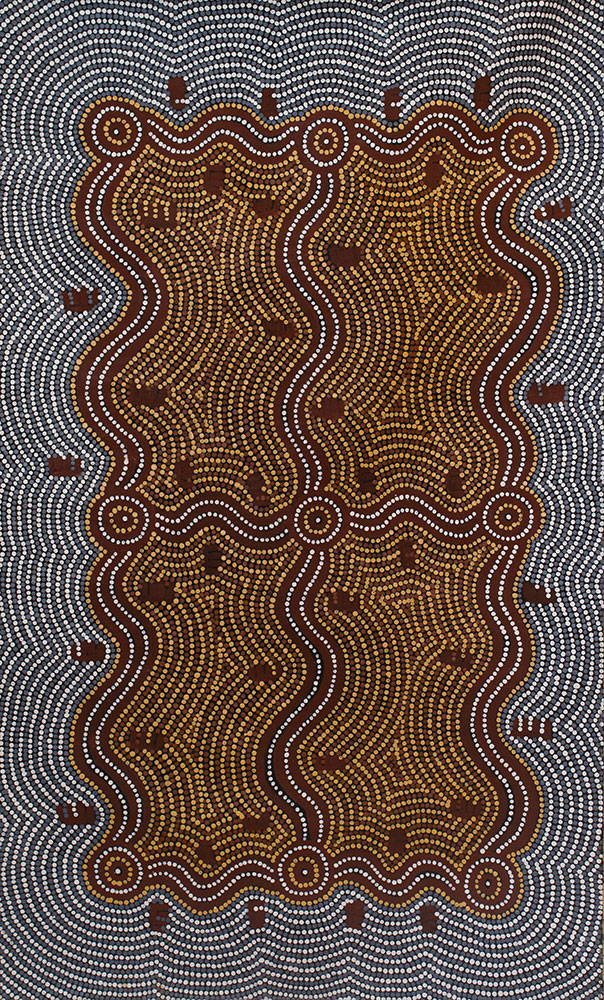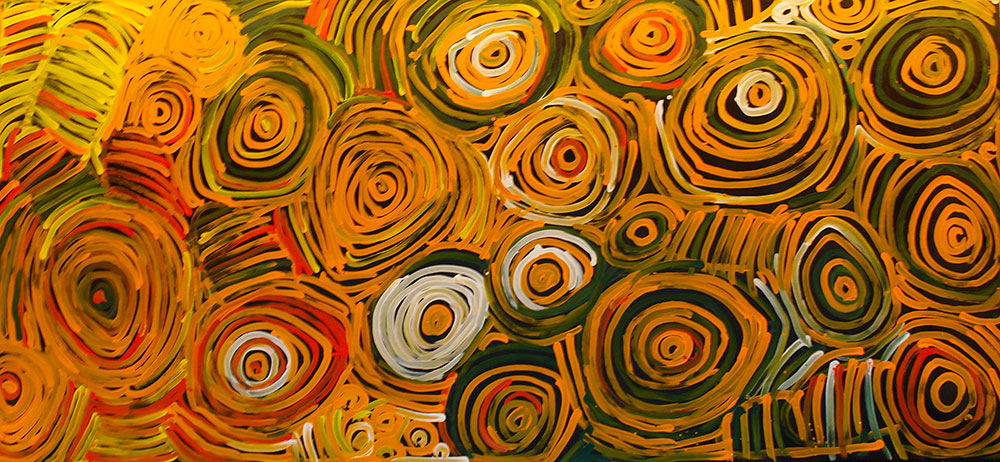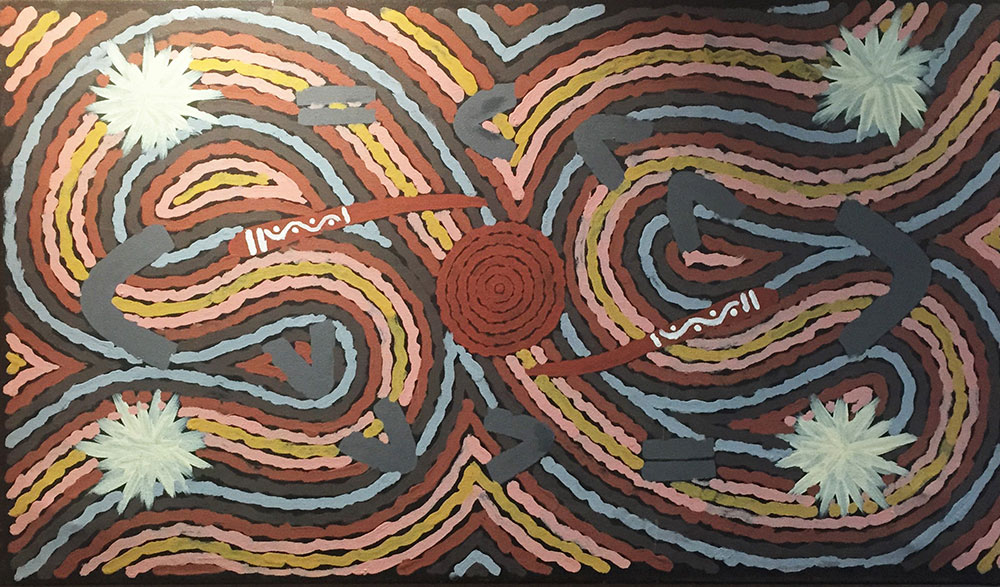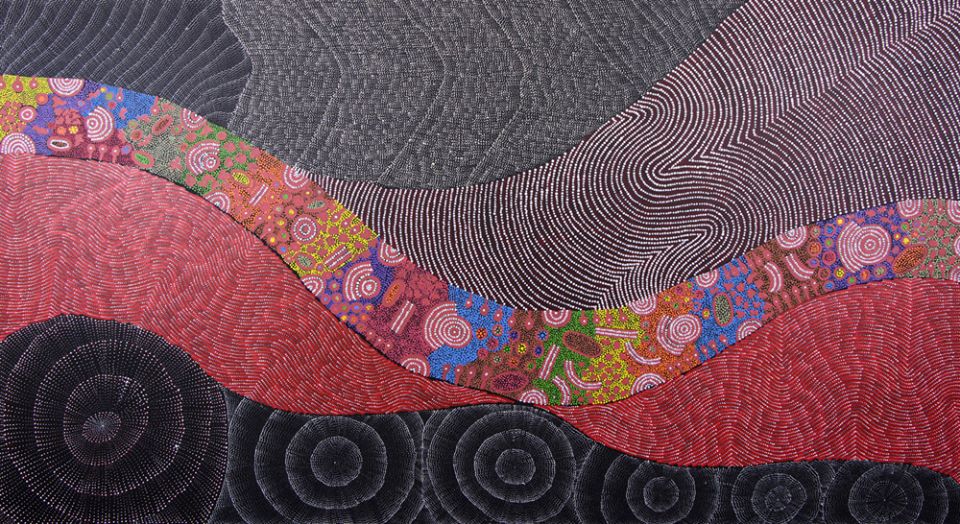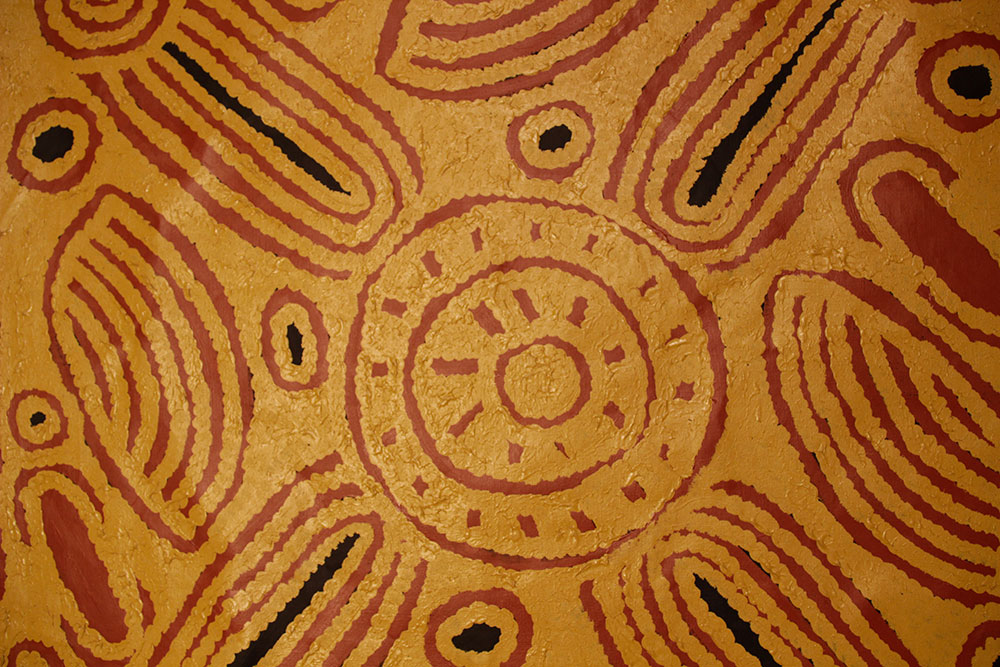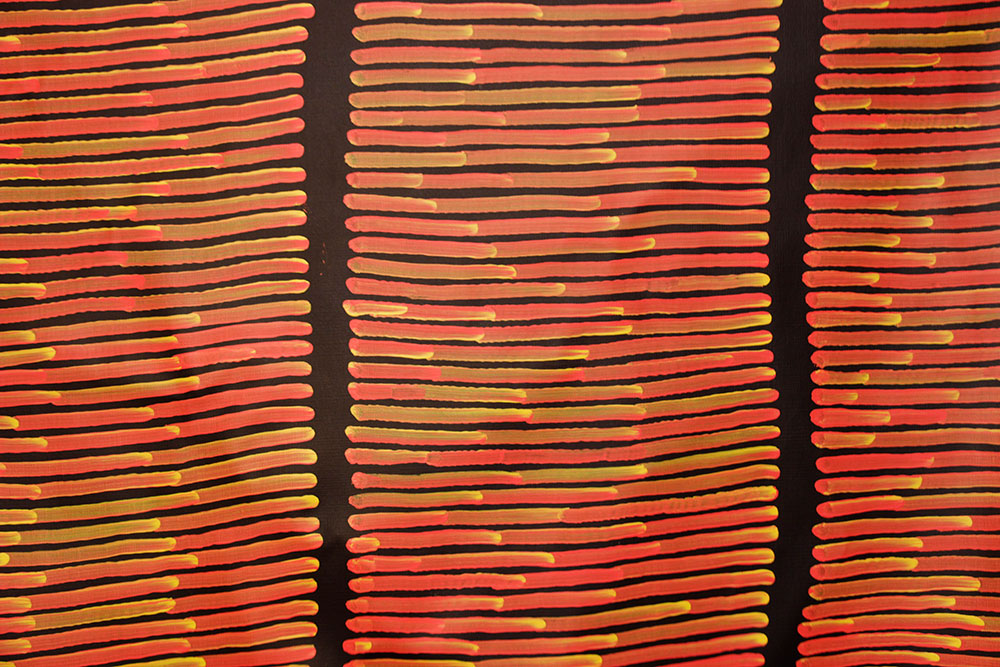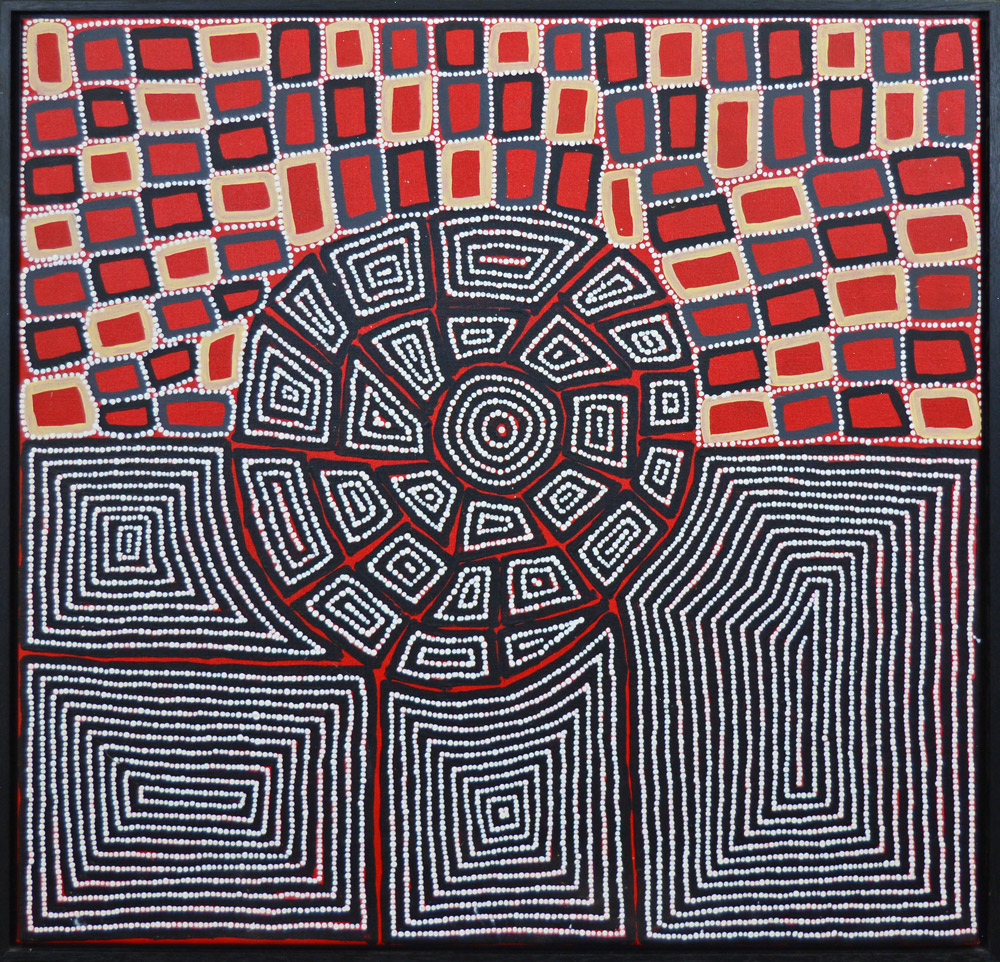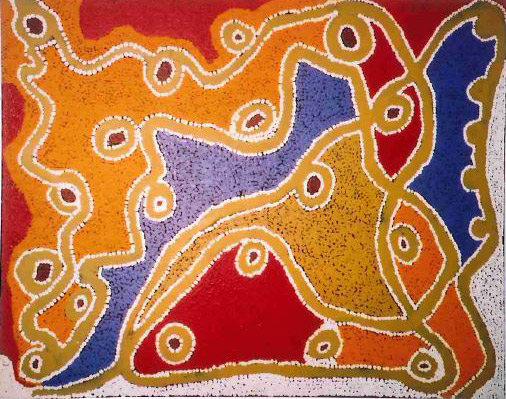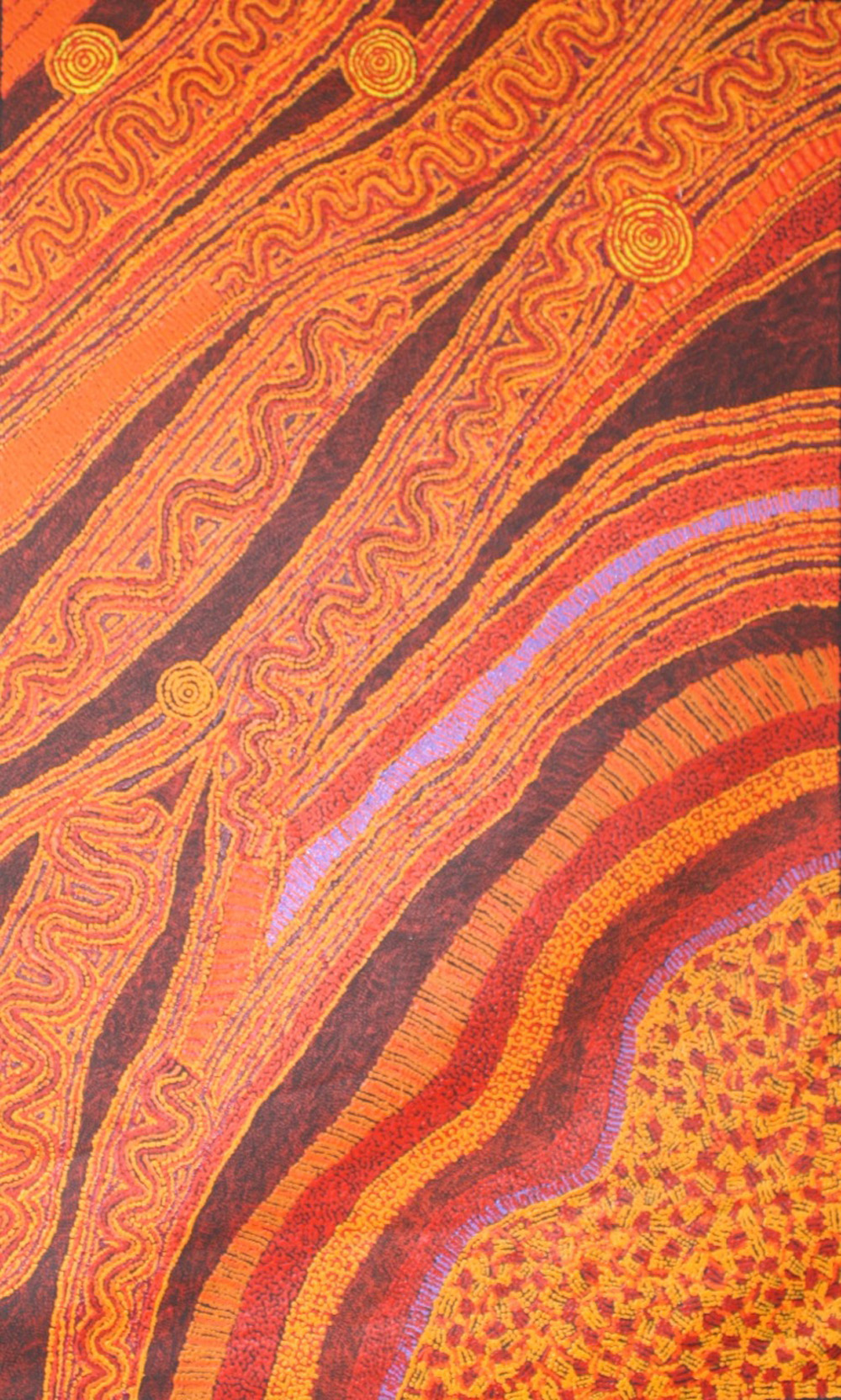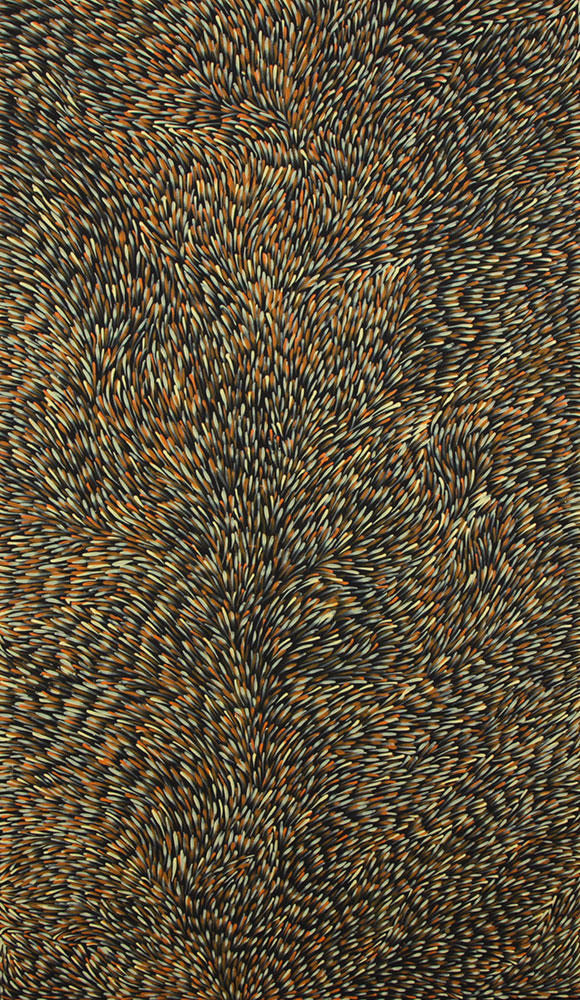Artist – Long Jack Phillipus Tjakamarra Papunya Tula Community : The collective, originally entirely Aboriginal Australian men, formed in 1972. They derived the name tula from a small hill near Papunya, a Honey Ant Dreaming site. A few women, notably Pansy Napangardi, began to paint for the company in the late 1980s. It was not until 1994 that women generally began to participate.The intial participation was helping their husbands with the boaders of her paintings through this Collaboration the Master would taught to appreciate to paint. For Papunya this period was from 1971-1980 and included at least 24 Original Shareholders. Long Jack Phillipus Tjakamarra is renowned Pintupi artist of the first generation (the Bardon years 1971–1973). Long Jack Phillipus is an important Australian artists responsible for the Aboriginal art movement and the foundation member of Papunya Tula Artists. Long Jack was among the first of the Aboriginal artists to paint under Geoffrey Bardon’s influence in the early 1970’s he was one of the artist who painted the mural on the walls and doors of the Papunya School. It was in the late 1980’s that Aboriginal people of Utopia started to put acrylic paint on canvas. This followed a very successful decade of working with batik, several years after the Papunya art movement began which put Utopia on the map, so to speak. Utopia women in particular are known as the leaders in female aboriginal art as well as their colourful contemporary appeal. Artist – Minnie Pwerle These paintings were predominately done by 1st Generation females from Utopian and would be incoroporate in the paintings depicting “awelye” women’s business ” Food depicted includes wild orange, wild passionfruit, wild fig, bush tomato, conkerberry, mistletoe, bush banana and bush coconut, quandongs, pencil yams, mulga apple, bush plums and sultanas. Edible seeds including mulga seeds, Grass Seeds and wattle seeds. Minnie began painting in 2000 at about the age of 80, and her pictures soon became popular and sought-after works of contemporary Indigenous Australian art. In the years after she took up painting on canvas, until she died in 2006, The dreaming’s Minnie painted included the bush tomato and the wild desert orange. The people of Utopia refer to the bush tomato as anemangkerr, and the wild desert orange as akarley. The fruits of both plants are represented on Minnie’s canvases by a circular shape. Artist – Clifford Possum Tjapaltjarri Papunya Tula artists sought to camouflage overt references to ceremony and became reticent. They revealed less of the sacred heart of their culture. The openness of the Bardon era was at an end. Dotting and over-dotting, as an ideal means of concealing or painting over dangerous, secret designs, became a fashion at this stage In most traditional Aboriginal communities boys are initiated into manhood in a cycle of ceremonies where they are taught their traditional songs and shown the dances that are associated with it. Among the people of Central Australia, like the Warlpiri, Arrarnta (Arrernte), Pitjantjatjara, Pintubi and many others, the rituals may take place over many weeks. The most common and most elaborate ceremonies among the Warlpiri people, for example, are the “kurdiji” initiation ceremonies in which a number of boys of the same subsection (or “skin”) are initiated together. “Kurdiji” means shield and refers to the wooden shields that are decorated with designs representing the “dreamings” or song cycles that are performed for that particular set of ceremonies The Clifford Possum painting is interesting a unique part of the painting is the centre which has the symbols painted on the aboriginal weapons Nulla …Nulla centre of the painting around the camp site. My Country Collaboration is an important different between Ultimate Art Gallery and other Major Galleries within Sydney. The theme is reflected in the collaborative piece which was done by the three Generation of the Kelly Family. Lilly and her sister Topsy Peterson Napangardi ; Lilly’s daughters Dolsi Kelly and Norma Kelly and Topsy Daughter Christine Peterson Nangala and Dolsi daughter Georgina Collaboration is an important part of Ultimate Art Four Seasons. Papunya Collaborative work by the Kelly Family across three Generations of Artist for one as Family is a centre piece The designs they use have been passed down for many generations, and only the Kelly Family owners can paint them. Each woman is permitted to bring her own style to the painting of the design. 2nd Generation Papunya Tula Commmunity painters from 1981- 1993. All these painters were working with the classic Pintupi grids of cycles and lines of travel signifying the journeys of their Tingari ancestors, infilled with cleanly – dotted outlines. The 2nd Generation Artists for Papunya were the wives of the 1st Generation Men the above Ningura Gibson was the wife of Yala Yala Gibbs. For Utopia the 2nd Generation Artist are the ones who weren’t part of the batik movement and started around the mid- Ninities. Ningura Napurrula was one of the leading contemporary Australian and International of the 21st century artists from post-WWII up until today. Ningura Napurrula was one of the eight great Australian artists whose work is featured in the collection of the Europe’s most important public museum Musée du quai Branly in Paris. Artist – Mick Namarari Tjapaltjarri The paintings normally denote the tracks left by the Animals and the food source of the Animals but sometimes include image of the Animals including kangaroo, emus, wild turkey, rock wallaby, possums, snakes and lizards and anteaters. Grubs and insects including witchetty grub, cicadas, caterpillars. These type of dreams are predominately done by Papunya Artist. Clifford Possum Worm Dreaming and Mick Namerari Marsupial Mouse are good examples. From early figurative works Mick Namerari moved on to creating large geometric designs that typified Papunya Tula art in the late 1970s and early 1980s. In the 1990s he began producing “minimalist” paintings that depicted the imprint of a kangaroo in the sand, the seeds that the marsupial mouse feeds upon, or the aftermath of hailstorms in the desert. Artist – Ronnie Tjampitjinpa The Exposition “Earth Wind and Fire”, refers to the natural elements that are common in the harsh Australian environment, and often included in the subject of Aboriginal Australian Art are some of the dreams classified in the other Category. Pintupi artist Ronnie Tjampitjinpa was one of the youngest of the group of men who began painting at Papunya in 1971, which led to the emergence of the Western Desert art movement. A founder of the hugely influential Papunya Tula Artists, he became as one of their major painters in the early 1990s and continues to paint today. Tjampitjinpa is most recognised for his bold, graphic paintings that explore the Tingari ancestors and their travels over vast areas of the Western Desert region. Ronnie’s art is a good representation of the characteristic Pintupi style: repetition of forms, which are geometric, simple and bold, and pigments which are often restricted to four basic colours of black, red, yellow and white. But Ronnie experiments with other colours as well. Artist – Tjapaltjarri Brothers The Pintupi Nine were a group of nine Pintupi people who lived a traditional hunter-gatherer desert-dwelling life in Australia’s Gibson Desert until 1984, when they made contact with their relatives near Kiwirrkurra. Collaboration is an important different between Ultimate Art Gallery and other Major Galleries within Sydney. The theme is reflected in the collaborative piece which was done by the first three of the four brothers (Warlimpirrnga, Walala, Tamlik and Yari Yari) of the Last Nomads tribe. Beside this collaborative piece we have individual pieces by the six known paintings on display in the Gallery of the tribe. The group roamed between waterholes near Lake Mackay, near the Western Australia-Northern Territory border, naked except for their hairstring belts and armed with 2m-long wooden spears and spear throwers, and intricately carved boomerangs. Their diet was dominated by goanna and rabbit as well as bush food native plants. The group was a family, consisting of two co-wives (Nanyanu and Papalanyanu) and seven children. There were four brothers (Warlimpirrnga, Walala, Tamlik, and Yari Yari) and three sisters (Yardi, Yikultji and Tjakaraia). The boys and girls were all in their early-to-late teens, although their exact ages were not known; the mothers were in their late 30s. My Country Irrunytju Community is a small Indigenous Australian community in Western Australia located about 1,700 kilometres (1,056 mi) east of Perth near the Western Australian-South Australian border in the Goldfields-Esperance region of Western Australia. Surrounded by large granite hills with mulga and mallee country, the community maintains many traditional activities such as hunting and gathering bush tucker as well as making many carved wooden artefacts. 3rd Generation The 3rd Generation Artist are the son and daughters of the wives who learnt to paint in Papunya for the original 24 Shareholders and same could be said for Utopia it was the Grand Sons and Grand Daughters of the original female batik painters. Gracie Ward Napaltjarri is the daughter of Wynne-Prize winning artist George Ward Tjungurrayi and esteemed elder Nyungawarra Ward Napurrula. Nyungawarra was the daughter of Charlie Ward Tjakamarra said to be one of the original Shareholders. It is very important for 3rd Generation artists to continue to paint so the Dreamings are never forgotten. In 2008 Gracie wanting to try something different, she started to work with Telstra Finalist Helen McCarthy to further develop her skills. Once given the opportunity to experiment, a bolder colour palette entered her oeuvre. Esther Bruno Nangala started to paint, receiving the benefit of a long apprenticeship under Naata Esther is the Grand- Daughter of Naata . Esther started to paint in her own right in 2009 since then she has made stunning leaps forward in the development of her own style and methodology for relating the stories around the important woman’s site of Marrapinti . Esther, along with Gracie Ward Napaltjarri, represents and exciting view into the future of desert art. Flora Flora is the plant life occurring in a particular region or time, generally the naturally occurring or indigenous the paintings normally depicts an aerial view of the surrounding country. Fuchsia bushes and bloodwood trees grow everywhere. Lemon grasses sprout on every ridge top and jirrpirinypa around every water hole. In the To End, many different kinds of large leaves are considered useful for staunching wounds, presumably because cases of profuse bleeding allow little time for searching. The above painting depicts particular leaves from plant species, which contain medicinal properties. The Aboriginal women from Utopia in Central Australia gather the leaves. The leaves are boiled, resin is added and mixed into a paste, which is used as bush medicine for many ailments. The Bush Medicine Dreaming is celebrated in their Awelye ceremonies Gloria is a very well know artist and significant figure in contemporary Indigenous Australian art. Gloria and her five sisters, Kathleen Petyarre, Ada Bird Petyarre (now passed away), Myrtle Petyarre, Violet Petyarre and Nancy Petyarre (now passed away) are all talented artists and the nieces of the famous Utopian artist Emily Kame Kngwarreye Artist – George Ward Tjungurrayi Aboriginal law and life originates in and is governed by the land. The connection to land gives Aboriginal people their identity and a sense of belonging. Their spiritual and cultural connection to the land obliges Aboriginal people to look after cultural sites which are ‘living museums’ of their ancestors. Land sustains Aboriginal lives in every aspect, spiritually, physically, socially and culturally. The notion of landscape as a second skin is central to every Aboriginal art form, whether it be theatre, dance, music or painting. Papunya Tula artists sought to camouflage overt references to ceremony and became reticent. They revealed less of the sacred heart of their culture. The openness of the Bardon era was at an end. Dotting and over-dotting, as an ideal means of concealing or painting over dangerous, secret designs, became a fashion at this stage George started painted in 1984. His paintings explore the Tingari cycle and stories associated with a sacred site near Lake MacDonald, a dreaming he is custodian of and which is also painted by Willy Tjungarrayi. In 2004, George Ward Tjungurrayi was honoured to receive the Wynne Prize, the prize awarded each year at the same time as the Archibald for the best Australian landscape painting. Artist – Yala Yala Gibbs Tjungurayyi Yala Yala Gibbs (founding member of the Papunya art movement and senior custodian of secret/sacred men business) was the eldest Willy is the middle one of three brothers and George Ward Tjungurrayi the youngest. They were all sons of Pulpalpulpalnga Tjapaltjarri but had different mothers. Willy began painting for Papunya Tula Artists in 1976. By the 1980s Willy was recognized as a senior Pintupi painter, and he joined the movement of return to the Pintupi homelands. He lived in Walungurru (Kintore) until 2003 and now splits his time between Alice Springs and Walungurru. George observed the work of his brothers Yala Yala and Willy Tjungurrayi, who were among Papunya’s Tula’s leading artists in Walungurru. In 1984 George Ward first painted on canvas: a handful of elegantly “classical” concentric roundel works from that time survive
Size – 152cm * 91cm
Year 1993
SKU: UltLJP005
Size – 228cm * 110cm
Year – 2005
MAGMIP001
Minnie’s work is often compared with that of her sister-in-law Emily Kame Kngwarreye, who also came from the Sandover and took up acrylic painting late in life. Minnie’s daughter, Barbara Weir, is a respected artist in her own right.
Size – 101cm x 59cm
Year – 1997
UltCPT002
Artist-Kelly Clan Collaborative work
Size – 250cm *120cm
Year – 2015
MAGKC002
Artist – Ningura Gibson Naparrula
Size – 126cm x 126cm
Year – 2010
UltNGN001
Size – 126cm x 60cm
Year 1985
UltMNT001
He died in Alice Springs in 1998, survived by his wife Elizabeth Nakamarra Marks and his daughter Angeline Nungurrayi
Size – 180cm *93cm
Year – 2010
ULTRT005
Size – 99cm * 101.5cm
Year – 2010
MAGTB003
Artist-Tommy Watson
Size – 150cm *120cm
Year – 2004
MAGKC002
Artist – Charmaine Pwerle
Size – 150cm * 90cm
Year – 2014
SKU: UltGRW003
Artist – Gloria Petyarre
Size – 205cm * 120cm
Year – 2007
UltGLP005
Size – 125cm x 142cm
Year 2009
SKU: UltGWT003
Size – 91.5cm x 91.5cm
Year – 1996
Pulpalpulpalnga Family
The community was established in the 1980s and was composed mainly of people from the Warburton mission. These people still have spiritual and ancestral ties to many parts of the region. Like other communities in the area, many came from South Australia because of rocket testing at Woomera.

